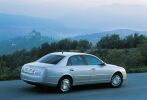 |
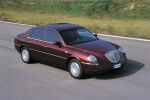 |
 |
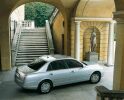 |
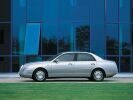 |
new models: Lancia Thesis
|
introduction
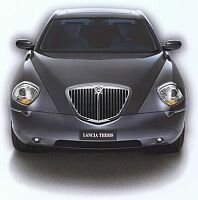 A large (4888mm long) four door luxury saloon, it is aimed to emphasise the brand as the luxury arm of the Fiat Group, a move already started with the Lybra. As such it features a substantial 'high-tech' content, a trend shown in the Nea concept car. This is based around the CONNECT system and a 7 inch TFT colour dispay in the dashboard and includes voice recognition, hands-free phone, a navigation system, a stereo, an optional TV and access to the contact centre. Other 'high-tech' systems include an optional radar cruise control, an optional sunroof with solar cells (which power the aircon fan when the vehicle is parked in the sun), a multizone climate control system which on some models has a separate zone for the rear passengers, front and rear parking sensor, a rain sensor, an automatic windscreen wiper system, automatic headlamps, LED tail-lights (with 30 LEDs per unit), optional variable power steering, bi-xenon headlights (with an automatic ride corrector which functions with both static and dynamic pitch changes) and more. To emphasise the comfort factor there is also power assistance when opening the doors, the seat and steering wheel move back and up to aid entrance when the door is opened, and the entire process of opening and starting the car is keyless, using a transponder in the drivers pocket. Some interior details can be seen here. An automatic handbrake (EPB or Electronic Parking Brake) is applied whenever the car is stopped and also features a button on the centre console for manual operation. As with all modern cars,
passive safety is an area emphasised in the press release, the Thesis featuring
eight airbags, comprising two multistage front bags, four sidebags and
two window-bags, seatbelts with pre-tensioners, adjustable headrests, ISOFIX
attachment points, a fire protection system and a carefully designed structure
including crumple zones and reinforced doors.
The design follows closely that of the Dialogos Concept car, and even moreso the example presented to the Pope. It is currently available as a four door saloon, a five door station wagon is expected to be released later. The official press release describes it as "hallmarked - in terms of styling - by exciting elegance going far beyond rational utility to leave space for the imagination, the Lancia Thesis matches retro sensations - such as the high front, the long bonnet and the profile resembling an upside-down wedge - with an entirely new stylistic language." It replaces the Kappa in production, but Fiat hopes that its success will follow that of the Thema rather than the Kappa.... Powerplants start with two versions of the well know 20 valve 5 cylinder in-line unit, a 2.0-litre turbocharged example (185bhp), and a 2.4-litre aspirated model (170bhp). The latter also features variable valve timing and a variable length induction system. A V6 derived from the Alfa Romeo 3-litre unit tops the range (215bhp), whilst a 2.4JTD (the 5-cylinder in-line family again, 150bhp) complete with variable geometry turbocharger and intercooler provides the oil-burning option. Rumours suggest that the latter will be joined later by a larger capacity GM sourced V6 diesel unit. The five cylinder engines use a six-speed manual gearbox, whilst the V6 gets a five speed automatic unit (with a sequential shift mode). |
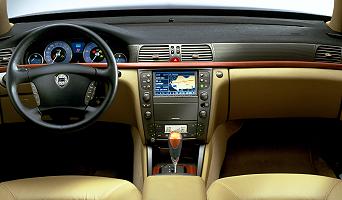 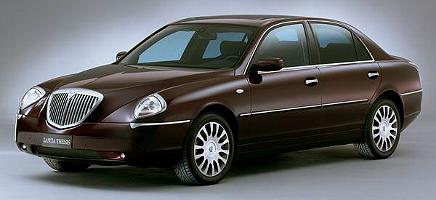 |
| equipment
Elegance and technology have
always been distinguishing features of any Lancia. In the Thesis flagship
they meld in an ideal balance to give us a range with two specifications.
These are known as Executive and Emblema and are equipped with a wealth
of standard equipment items that are complemented by some exclusive devices
on Emblema versions. Both specifications share four engines (three petrol
and one common rail turbodiesel) and two gearboxes (the five-speed self-adaptive
sequential automatic transmission is fitted to the 3.0 V6 24v while the
6 speed manual unit is fitted to all the other power units. Plus four different
interiors, twelve body colours and a host of options able to satisfy even
the most demanding section of customers within this élite market
band.
Other equipment designed
to ease life on board and offered by both the Thesis Executive and Thesis
Emblema include: automatic climate control system, sound system with integral
radio and steering wheel controls, Cruise Control and trip computer plus
a 7" colour screen. And also: electric windows with anti-obstruction sensor
on all four doors, heated, electrically-adjustable door mirrors, electric
handles, electric door locks and catches with multifunction remote control,
adjustable front armrest with oddments compartment and climate controlled
outlet - and rear armrest with ski tunnel.
- an electronic ring-type
accelerator that converts a pedal-operated accelerator into a steering
wheel control;
All these devices are built by the best companies in the sector and fit perfectly into the passenger compartment without impairing car user-friendliness, passenger room, comfort and safety. They can also be fitted alongside standard controls to enable the car to be driven by people without motor difficulties as well. |
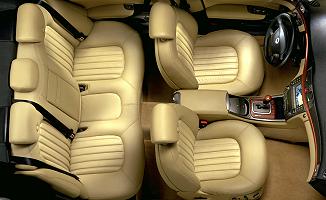 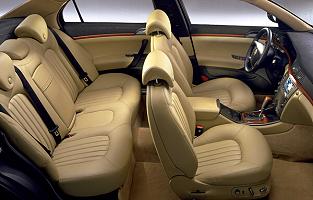 |
| engines
The Lancia Thesis assures
outstanding performance. The two litre engines, for example, are absolutely
outstanding when compared with other engines of the same capacity offered
by the competition. Car handling and agility are also important. Especially
when you consider that a car just under five metres long with a weight
to match has to work harder to achieve a good result.
The 2.0 20v Turbo Soft, in
particular, is confirmation of Lancia's engine building traditions: the
brand has always achieved outstanding results with this engine capacity.
On the Lancia Thesis, the thermodynamic efficiency of this power unit is
combined with a smooth, gradual turbo action able to assure outstanding
comfort with scintillating performance comparable to that of a far bigger
aspirated engine.
The Lancia Thesis 2.4 20v,
is an interesting car because it offers satisfactory power and speed levels,
all the brio required for vigorous take-off and pick-up and the ability
to cover around 12 kilometres out of town on a litre of fuel.
The gearboxes are slick,
smooth-shifting, silent: they include a six-speed manual and a 5-speed
automatic that are outstanding for their sophisticated, innovative engineering.
Both offer the best possible channel for power transmitted by the engines
(150 to 215 bhp) and ensure the car delivers uniformly crisp performance.
They are also so easy and satisfying to use that any driver can handle
a great saloon like the Lancia Thesis with ease and panache.
|
| Driveline | transverse engine at front with front wheel drive |
| Engines | 1998cc (82x75.65mm) 5 cylinder 20V turbo with 185bhp
2446cc (83x90.4mm) 5 cylinder 20V with 170bhp 2959cc (93x72.6mm) 24V V6 with 215bhp 2387cc (82x90.4mm) 5 cylinder JTD diesel with 150bhp |
| Suspension | front : Multilink with telescopic dampers and coil
springs plus anti-roll bar
rear : Multilink with telescopic dampers and coil springs plus anti-roll bar semi-active 'Skyhook' system wheelbase : 2803mm track (front/rear) : 1569mm/1541mm |
| Brakes | front : discs, ventilated, diameter 305mm
rear : discs, ventilated, diameter 281mm ABS EBD (electronic brake-force distribution) |
| Gearbox | 6 speed manual (cable operated)
5 speed automatic (with sequential shift mode) |
| Steering | Rack and pinion with power assistance |
| Kerb weight | 2.0 20V turbo : 1695kg
2.4 20V : 1680bhp 3.0 24V V6 : 1750kg 2.4 JTD : 1715kg |
| model | max speed | 0-100km/h | standing km |
| 2.0 20V turbo | 224 km/h | 8.9 sec | 28.9 sec |
| 2.4 20V | 217 km/h | 9.5 sec | 30.2 sec |
| 3.0 24V V6 | 234 km/h | 9.2 sec | 29.8 sec |
| 2.4 JTD | 206 km/h | 10.1 sec | 31.4 sec |
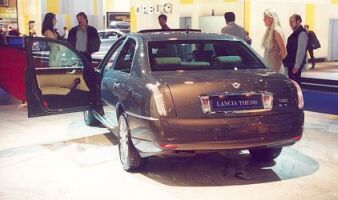 see the Thesis unveiled at the 2001
Frankfurt Motor Show
see the Thesis unveiled at the 2001
Frankfurt Motor Show |
| advanced technology
The Lancia Thesis also interfaces with its driver in an appealing, practical way: from instrument panel to central console. Here you can find a seven-inch colour screen flanked on either side by switches for direct access to the various menus and completed underneath by a row of reconfigurable keys. The keys change function according to the menu selected for user-friendly virtual communication. They are used to control CONNECT, the sophisticated integrated telematic system that connects users to the world of services offered by Targasys.
|
| invisible technology: Skyhook
The intention is to offer those who travel in the Lancia Thesis exclusive satisfaction. The car comes fitted as standard with a Skyhook (so-called because it allows the car to move as though it were suspended from the sky). The system is restricted to a few élite cars and takes the form of a semi-active damping system that has been developed for the Lancia flagship itself. The system was developed by Mannesmann-Sachs and takes the form of 6 sensors that determine relative speed between body and wheels in order to choose the optimum damping force to be provided by each individual shock absorber. Instantaneous sensor recordings and shock absorber regulation during compression and regulation make it possible for the system to brake the car's vertical motion at every moment just as though the body were hanging from the sky. Skyhook represents a true
step forward in shock absorber calibration because it means that the designers
no longer have to seek a compromise between stability, safety and comfort.
It is also a vast improvement on current discrete damping control systems
that offer a restricted adjustment range. The shock absorber valves on
the system offered on the Lancia Thesis are controlled by an electronic
control unit that screens factors such as load, road conditions, car motion
and driver reactions. This enables the Skyhook system to choose the damping
setting best suited to car driving conditions from an infinite range of
possibilities within a few milliseconds and independently for each wheel.
This helps highlight driving satisfaction under conditions of absolute
safety.
|
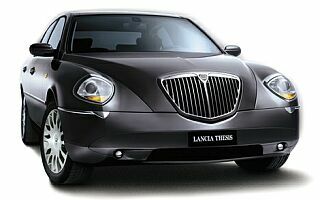 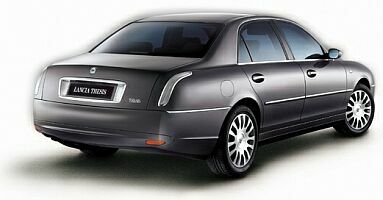 |
| exterior styling
The Lancia Thesis is a big
luxury car that measures a little under five metres in length and displays
certain motifs that bring part glories into the present: high front, long
bonnet and an upturned wedge-shaped profile. These traits are, however,
immediately offset by smooth curves and crisp corners combined in a completely
new stylistic language.
The sides and front reveal
only the barest hints of chrome here and there. Here: a subtle thread framing
the long, dark shape of the windows and two inserts to set off the door
handles. There: the grille and triangular headlamp surround.
|
 |
The Lancia Thesis drew heavily in both styling and technology on the 1998 Lancia Dialogos concept car, which was brimming full of new advanced technological ideas. |
|
| <<< |